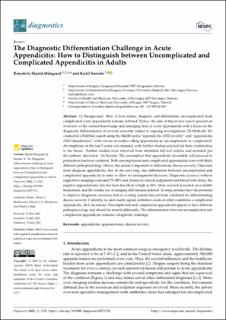| dc.contributor.author | Skjold-Ødegaard, Benedicte | |
| dc.contributor.author | Søreide, Kjetil | |
| dc.date.accessioned | 2022-09-22T08:09:16Z | |
| dc.date.available | 2022-09-22T08:09:16Z | |
| dc.date.created | 2022-09-16T12:30:58Z | |
| dc.date.issued | 2022-07-15 | |
| dc.identifier.issn | 2075-4418 | |
| dc.identifier.uri | https://hdl.handle.net/11250/3020541 | |
| dc.description.abstract | Background: How to best define, diagnose and differentiate uncomplicated from complicated acute appendicitis remains debated. Hence, the aim of this review was to present an overview of the current knowledge and emerging field of acute appendicitis with a focus on the diagnostic differentiation of severity currently subject to ongoing investigations.
Methods: We conducted a PubMed search using the MeSH terms “appendicitis AND severity” and “appendicitis AND classification”, with a focus on studies calling appendicitis as ‘uncomplicated’ or ‘complicated’. An emphasis on the last 5 years was stressed, with further studies selected for their contribution to the theme. Further studies were retrieved from identified full-text articles and included per the authors’ discretion.
Results: The assumption that appendicitis invariably will proceed to perforation has been outdated. Both uncomplicated and complicated appendicitis exist with likely different pathophysiology. Hence, this makes it important to differentiate disease severity. Clinicians must diagnose appendicitis, but, in the next step, also differentiate between uncomplicated and complicated appendicitis in order to allow for management decisions. Diagnostic accuracy without supportive imaging is around 75–80% and, based on clinical judgement and blood tests alone, the negative appendectomy rate has been described as high as 36%. More research is needed on available biomarkers, and the routine use of imaging still remains debated. Scoring systems have the potential to improve diagnostic accuracy, but no scoring system has yet been validated for differentiating disease severity. Currently, no universally agreed definition exists on what constitutes a complicated appendicitis.
Conclusions: Uncomplicated and complicated appendicitis appear to have different pathophysiology and should be treated differently. The differentiation between uncomplicated and complicated appendicitis remains a diagnostic challenge. | en_US |
| dc.language.iso | eng | en_US |
| dc.publisher | MDPI | en_US |
| dc.rights | Navngivelse 4.0 Internasjonal | * |
| dc.rights.uri | http://creativecommons.org/licenses/by/4.0/deed.no | * |
| dc.title | The diagnostic differentiation challenge in acute appendicitis: How to distinguish between uncomplicated and complicated appendicitis in adults | en_US |
| dc.type | Journal article | en_US |
| dc.type | Peer reviewed | en_US |
| dc.description.version | publishedVersion | en_US |
| dc.rights.holder | Copyright 2022 the authors | en_US |
| dc.source.articlenumber | 1724 | en_US |
| cristin.ispublished | true | |
| cristin.fulltext | original | |
| cristin.qualitycode | 1 | |
| dc.identifier.doi | 10.3390/diagnostics12071724 | |
| dc.identifier.cristin | 2052459 | |
| dc.source.journal | Diagnostics | en_US |
| dc.identifier.citation | Diagnostics. 2022, 12 (7), 1724. | en_US |
| dc.source.volume | 12 | en_US |
| dc.source.issue | 7 | en_US |

